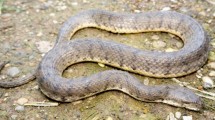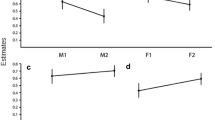Abstract
A 5-year mark-recapture study of smooth snakes (Coronella austriaca) in the Carnic Alps (1100 m above sea level) of north-eastern Italy provided extensive information on the biology and life-history of these small viviparous snakes. Offspring were relatively large (mean=15 cm total length, 2.9 g) when they were born in late summer, and females grew to maturity (44 cm, 50 g) in approximately 4 years. Larger neonates retained their size advantage for at least 12 months, but did not have a higher probability of survival. Although sexual size dimorphism (at birth and at mean adult body sizes) was minor, the sexes differed significantly in several respects. Females grew faster than males during juvenile life, and adult females diverged in dietary habits from the rest of the population. Whereas juveniles (of both sexes) and adult males fed primarily on lizards, larger females shifted to feeding less frequently, but taking larger prey (mammals and snakes). Reproductive output increased strongly with maternal body size: larger females reproduced more frequently, produced larger litters of larger neonates, had higher relative clutch masses (RCMs), and had a lower proportion of stillborn off-spring. Most females produced a litter every 2nd or 3rd year. We did not detect significant year-to-year variation in reproductive traits over the 5 years of our study. Females were consistent from one litter to the next in several traits (e.g., litter sizes, offspring sizes and shapes, proportions of stillborn neonates, RCMs), but this consistency was due to differences in body size among females rather than to size-independent maternal effects. Overall litter sex ratios averaged 50/50, but sex ratios tended to be more male-biased in litters that were unusually large relative to maternal body size, and in litters containing a high proportion of stillborn offspring. “Costs” of reproduction appear to be high in this population, in terms of both energy allocation and risk. Reproduction reduced growth rates, and females that recovered condition more quickly in the year after reproduction were able to reproduce again after a briefer delay. Mortality was highest in reproducing females with high RCMs, and in females that were very emaciated after parturition. The marked increase in reproductive output with increasing maternal body size in C. austriaca may reflect a reduction in “costs” as females grow larger, and the dietary shift to larger prey may enhance the rate that females can accumulate energy for reproduction.
Similar content being viewed by others
References
Agrimi U, Luiselli L (1994) Ecology of the snake Coronella girondica (Reptilia:Colubridae) in central Italy. Vie Milieu 44:203–210
Andren C (1985) Risk of predation in male and female adders, Vipera berus (Linné). Amphib-Reptil 6:203–206
Andren C, Nilson G (1976) Hasselsnoken (Coronella austriaca) —en utrotningshotad ormart. Fauna Flora 2:61–76
Arnold EN, Burton JA (1978) A field guide to the reptiles and amphibians of Britain and Europe. Collins, London
Blem CR (1982) Biennial reproduction in snakes: an alternative hypothesis. Copeia 1982:961–963
Brown WS (1991) Female reproductive ecology in a northern population of the timber rattlesnake, Crotalus horridus. Herpetologica 47:101–115
Bull JJ, Shine R (1979) Iteroparous animals that skip opportunities for reproduction. Am Nat 114:296–316
Capula M, Luiselli L (1993) Ecology of an alpine population of the slow worm, Anguis fragilis Linnaeus 1758. Thermal biology of reproduction. Herpetozoa 6:57–63
Capula M, Luiselli L (1994) Reproductive strategies in alpine adders, Vipera berus. The black females bear more often. Acta Oecol 14:207–214
Capula M, Luiselli L, Anibaldi C (1992) Complementary study on the reproductive biology in female adder, Vipera berus (L.), from eastern Italian Alps. Vie Milieu 42:327–336
Congdon JD, Gibbons JW (1987) Morphological constraint on egg size: a challenge to optimal egg size theory? Proc Natl Acad Sci USA 84:4145–4147
Duguy R (1961) Le cycle annuele d'activité de Coronella austriaca Laur.; d'apres les observations manuscrites inédités de Raymond Rollinat. Terre Vie 15:401–435
Goddard P (1984) Morphology, growth, food habits and population characteristics of the smooth snake Coronella austriaca in southern Britain. J Zool Lond 204:241–257
Goddard P, Spellerberg IF (1980) Reproduction as a factor in the conservation of Coronella austriaca in southern England. Bull Ecol 11:535–541
Greene HW (1986) Natural history and evolutionary biology. In: Feder ME, Lauder GV (eds) Predator-prey relationships: perspectives and approaches from the study of lower vertebrates. University of Chicago Press, Chicago, pp 99–108
Huey RB, Pianka ER, Schoener TW (1983) Lizard ecology: studies of a model organism. Harvard University Press, Cambridge
Leger DW, Didrichson IA (1994) An assessment of data pooling and some alternatives. Anim Behav 48:823–832
Lott DF (1991) Intraspecific variation in the social systems of wild vertebrates. Cambridge University Press, Cambridge
Luiselli L (1992) Reproductive success in melanistic adders: a new hypothesis and some considerations on Andren and Nilson's (1981) suggestions. Oikos 64:601–604
Madsen T, Shine R (1992a) Determinants of reproductive success in female adders, Vipera berus. Oecologia 92:40–47
Madsen T, Shine R (1992b) Sexual competition among brothers may influence offspring sex ratio in snakes. Evolution 46:1549–1552
Madsen T, Shine R (1993) Costs of reproduction in a population of European adders. Oecologia 94:488–495
Madsen T, Shine R, Loman J, Håkansson T (1993) Determinants of mating success in male adders, Vipera berus. Anim Behav 45:491–499
McGinley MA (1989) The influence of a positive correlation between clutch size and offspring fitness on the optimal offspring size. Evol Ecol 3:150–156
Parker GA, Begon M (1986) Optimal egg size and clutch size: effects of environment and maternal phenotype. Am Nat 128:573–592
Peterson CR, Gibson AR, Dorcas ME (1993) Snake thermal ecology: the causes and consequences of body-temperature variation. In: Seigel RA, Collins JT (eds) Snakes: ecology and behavior. McGraw-Hill, New York, pp 241–314
Pianka ER, Parker WS (1975) Age-specific reproductive tactics. Am Nat 109:453–464
Roff DA (1992) The evolution of life histories. Chapman and Hall, New York
Rugiero L, Capula M, Luiselli L (1994) Scelta dell habitat in una populazione alpina di Coronella austriaca (Reptilia, Colubridae) in relazione allo stato riproduttino. Boll Mus Reg Sci Nat Torino 12, in press
Rugiero L, Capula M, Filippi E, Luiselli L (1995) Food habits of Mediterranean populations of the smooth snake, Coronella austriaca. Herpetol J, (in press)
Seigel RA (1993) Summary: future research on snakes, or how to combat “lizard envy”. In: Seigel RA, Collins JT (eds) Snakes: ecology and behavior. McGraw-Hill, New York, pp 395–402
Seigel RA, Ford NB (1987) Reproductive ecology. In: Seigel RA, Collins JT, Novak SS (eds) Snakes: ecology and evolutionary biology. Macmillan, New York, pp 210–252
Seigel RA, Fitch HS, Ford NB (1986) Variation in relative clutch mass in snakes among and within species. Herpetologica 42:179–185
Seigel RA, Huggins MM, Ford NB (1987) Reduction in locomotor ability as a cost of reproduction in snakes. Oecologia 73:481–465
Shine R (1980) “Costs” of reproduction in reptiles. Oecologia 46:92–100
Shine R (1986) Sexual differences in morphology and niche utilization in an aquatic snake, Acrochordus arafurae. Oecologia 69:260–267
Shine R, Harlow P (1993) Maternal thermoregulation influences offspring viability in a viviparous lizard. Oecologia 96:122–127
Shine R, Schwarzkopf L (1992) The evolution of reproductive effort in lizards and snakes. Evolution 46:62–75
Spellerberg IF, Phelps TE (1977) Biology, general ecology and behaviour of the snake, Coronella austriaca Laurenti. Biol J Linn Soc 9:133–164
Stewart JR (1979) The balance between number and size of young in the live bearing lizard Gerrhonotus coeruleus. Herpetologica 35:342–350
Strijbosch H, Van Gelder JJ (1993) Okologie und biologie der schlingnatter, Coronella austriaca Laurenti 1768 in den Niederlanden. Mertensiella 3:39–58
Turner FB (1977) The dynamics of populations of squamates, crocodilians and rhyncocephalians. In: Gans G, Tinkle DW (eds) Biology of the Reptilia. Academic Press, New York, pp 157–264
Vitt LJ, Congdon JD (1978) Body shape, reproductive effort, and relative clutch mass in lizards: resolution of a paradox. Am Nat 112:595–608
Waitzmann M, Sandmaier P (1990) Zur Verbreitung und Habitatwahl der Reptilien im Donautal zwischen Passau und Linz (Niederbayern, Oberosterreich). Herpetozoa 3:25–53
Williams GC (1966) Adaptation and natural selection. Princeton University Press, Princeton
Zinner H (1985) On behavioral and sexual dimorphism of Telescopus dhara Forscal 1776 (Reptilia: Serpentes, Colubridae). J Herpetol Assoc Afr 31:5–6
Author information
Authors and Affiliations
Rights and permissions
About this article
Cite this article
Luiselli, L., Capula, M. & Shine, R. Reproductive output, costs of reproduction, and ecology of the smooth snake, Coronella austriaca, in the eastern Italian Alps. Oecologia 106, 100–110 (1996). https://doi.org/10.1007/BF00334412
Received:
Accepted:
Issue Date:
DOI: https://doi.org/10.1007/BF00334412




